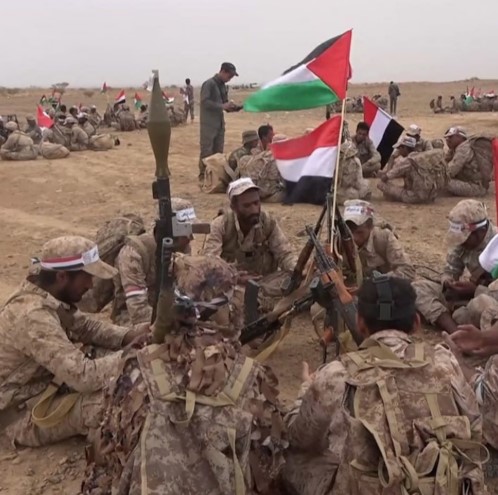On December 28, 2024, Israel launched a series of airstrikes on Yemen, including attacks on the capital Sana’a and the country’s main airport.
The Background of Israel’s Strikes in Yemen
This move is part of Israel’s broader military campaign targeting the Houthi militant group, also known as Ansar Allah. The Houthis have been active in the ongoing civil war in Yemen, and Israel’s strikes are part of a larger strategy against Iranian-backed groups in the region, including Hamas and Hezbollah. The attack on Yemen’s airport was particularly significant, as it coincided with the presence of a United Nations delegation, raising concerns about the impact of the escalation on humanitarian efforts.
Israel’s actions are not isolated; they come after a series of operations aimed at weakening the Houthis. These strikes are part of Israel’s campaign to target Iranian proxies and diminish the influence of Tehran in the region. The Israeli air force has previously shown the ability to carry out long-distance missions, such as Operation Long Arm in July 2024, which responded to a Houthi drone attack disrupting humanitarian operations in Yemen. The current escalation, however, appears to be larger in scale, with the bombing of Sana’a marking a significant development in the conflict.
The Role of the Houthis in the Yemeni Civil War
The Houthis, a Zaidi Shia militant group, have been at the center of the Yemeni civil war since 2014. The conflict started when the Houthis seized control of Yemen’s capital, Sana’a, and later expanded their territory. This led to a complex war involving various factions, including the internationally recognized government of Yemen, supported by a Saudi-led coalition, and the UAE-backed separatist groups.
Despite facing significant opposition, including airstrikes by Saudi Arabia and the UAE, the Houthis have managed to maintain control over large parts of Northern Yemen. They have increasingly gained military power, aided by Iranian military support, which has bolstered their capabilities. The Houthis’ ability to strike key ports and disrupt global shipping routes in the Red Sea has increased their significance on the international stage. This impact has been felt by commercial shipping companies, which have had to navigate around Yemen, leading to higher insurance premiums and delays in shipping routes.
Israel’s recent strikes represent an intensification of its efforts to target the Houthi group, which has become an increasingly important player in the region. In addition to being involved in Yemen’s civil war, the Houthis have also aligned themselves with Iran’s broader network of militias, known as the “axis of resistance,” which includes Hezbollah in Lebanon and Hamas in Gaza. Their relationship with Iran, and their mutual opposition to Israel, has made them a target of Israeli military operations.
The Houthis and the “Axis of Resistance”
The Houthis’ connection to Iran is a key factor in their role within the broader Middle Eastern conflicts. As Israel has weakened other elements of the Iranian-backed forces, such as Hamas and Hezbollah, the Houthis have emerged as one of Iran’s most significant allies in the region. The Houthis’ military capabilities, which include the use of missiles, drones, and naval strikes, have made them an effective tool in Iran’s strategy against Israel.
Since the outbreak of violence in Gaza in October 2023, the Houthis have increasingly focused their efforts on confronting Israel. They launched missile and drone attacks against Israel, marking a shift from their previous focus on the Yemeni conflict. They have also used the maritime route in the Red Sea to carry out attacks on shipping and disrupt global trade. In doing so, they have amplified their defiance against Israel, even as the Israeli military continues its bombardment of Gaza.
The Houthis have also strengthened their ties with other Iranian-backed groups. For instance, in 2024, the Houthis opened an office in Baghdad, signaling their closer coordination with the Iraqi-based Popular Mobilization Forces (PMF), also known as Hashd al-Shaabi. This collaboration has allowed the Houthis to expand their influence beyond Yemen and into the broader Middle Eastern conflict, particularly in opposition to Israeli interests.
Houthi Control and Global Implications in Yemen Conflict
In Yemen, the Houthis continue to exert significant control. By early 2024, the group had announced a surge in recruitment, with estimates suggesting between 150,000 to 200,000 new fighters. Despite challenges from other factions in the civil war, such as the UAE-backed Southern Transitional Council, the Houthis have maintained their position as one of the dominant forces in Yemen. The ongoing international focus on their actions further complicates this situation, particularly as the United States and its allies continue to target their military infrastructure.
The conflict in Yemen has become an increasingly complex battleground involving global powers and regional actors. Israel’s decision to expand its airstrikes against the Houthis is part of its broader strategy to weaken Iranian influence in the region, but it also highlights the growing significance of the Houthis as a military force. The situation remains fluid, and the ongoing conflict continues to have far-reaching consequences for the Middle East and beyond.

